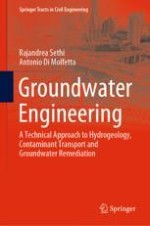2019 | OriginalPaper | Chapter
15. Characterization of a Contamination Event
Authors : Rajandrea Sethi, Antonio Di Molfetta
Published in: Groundwater Engineering
Publisher: Springer International Publishing
Activate our intelligent search to find suitable subject content or patents.
Select sections of text to find matching patents with Artificial Intelligence. powered by
Select sections of text to find additional relevant content using AI-assisted search. powered by
